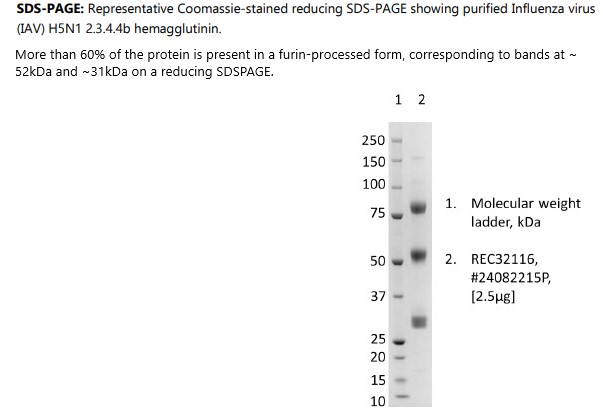Avian influenza A(H5N1) clade 2.3.4.4b Hemagglutinin (HA)
Price range: $491.88 through $1,725.79 excl. VAT
Recombinant highly pathogenic avian influenza (HPAI) virus H5N1 clade 2.3.4.4b hemagglutinin (HA), containing a C-terminal T4 foldon-His-tag. This protein was produced in HEK293 cells and purified using affinity chromatography and ion exchange chromatography. More than 60% of the protein is present in a furin-processed form, corresponding to bands at ~52kDa and ~31kDa on a reducing SDS-PAGE.
Avian influenza A(H5N1) clade 2.3.4.4bHemagglutinin (HA)
Recombinant highly pathogenic avian influenza (HPAI) virus H5N1 clade 2.3.4.4b hemagglutinin (HA), containing a C-terminal T4 foldon-His-tag. This protein was produced in HEK293 cells and purified using affinity chromatography and ion exchange chromatography. More than 60% of the protein is present in a furin-processed form, corresponding to bands at ~52kDa and ~31kDa on a reducing SDS-PAGE.
PRODUCT DETAILS – Avian influenza A(H5N1) clade 2.3.4.4b Hemagglutinin (HA)
- Recombinant Avian influenza A(H5N1) clade 2.3.4.4b hemagglutinin (HA)
- Expressed in HEK293 (Acc. No.: EPI3334182)
- Tag: 6xHis-tag, C-terminal
- Presented as liquid in Dulbecco’s PBS, pH 7.4
BACKGROUND
Avian influenza strains are categorized into two types based on their pathogenicity: high pathogenicity (HP) and low pathogenicity (LP). The most well-known HPAI strain, H5N1, was first isolated in 1996 from a farmed goose in Guangdong Province, China. Low pathogenic strains have also been identified in North America.
Avian influenza A(H5N8), an emerging HPAI virus, was first reported in January 2014. That same year, HPAIs of subtype H5 caused outbreaks in poultry across Europe, North America, and East Asia. In 2015, two HPAI strains, A(H5N2) and A(H5N8), were detected in wild birds and poultry in the US and Canada. These strains caused outbreaks in 17 US states, affecting more than 11 million birds. Despite the extensive poultry outbreaks and human exposure, follow-up studies found no human illness.
During the winter of 2016-2017, many European countries and Russia reported HPAI A(H5N8) in various wild bird species, including migratory birds. By October 2017, the European Union Reference Laboratory for Avian Influenza had reported 2,781 outbreaks of H5N8 in poultry, wild birds, and captive birds. A review of these outbreaks involving 524 exposed individuals revealed no human infections based on PCR testing. The viruses found in Europe in 2016-2017 were closely related to those detected in North America in 2014-2015, though they were distinguishable (Adlhoch et al., 2018).
The current HPAI H5N1 strain is of particular concern due to its frequent transmission to mammals. In late 2021, the Eurasian strain of H5N1 (clade 2.3.4.4b) was identified in North America, triggering an outbreak that continued into 2024. This strain has caused spillover infections and deaths in both terrestrial and marine mammals in the United States. The detection of this clade in severe human cases in Ecuador and Chile has further raised concerns about the pandemic potential of certain HPAI strains (Burrough ER, et al.).
The World Health Organization (WHO) reports that between 2003 and August 2024, there have been 903 human cases of influenza A(H5N1) infections across 24 countries, including the most recent case. Nearly all human infections have been linked to close contact with A(H5N1)-infected birds, mammals, or contaminated environments. Vaccines for seasonal influenza do not protect A(H5N1), though some countries have developed candidate vaccines for influenza A(H5) infection as part of their pandemic preparedness efforts (WHO).
REFERENCES
- Adlhoch C, Dabrera G, Penttinen P, Pebody R; Country Experts. Protective Measures for Humans against Avian Influenza A(H5N8) Outbreaks in 22 European Union/European Economic Area Countries and Israel, 2016 to 2017. Emerg Infect Dis. 2018 Oct;24(10):1-8.
- Burrough ER, Magstadt DR, Petersen B, Timmermans SJ, Gauger PC, Zhang J, et al. Highly Pathogenic Avian Influenza A(H5N1) Clade 2.3.4.4b Virus Infection in Domestic Dairy Cattle and Cats, United States, 2024. Emerg Infect Dis. 2024;30(7):1335-1343. https://doi.org/10.3201/eid3007.240508
- WHO (2 September 2024) Avian Influenza A (H5N1) – Cambodia, World Health Organization. World Health Organization. Available at: https://www.who.int/emergencies/disease-outbreak-news/item/2024-DON533



